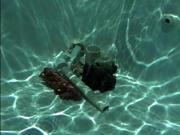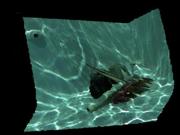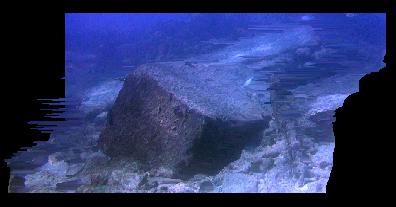Yoav Y. Schechner: Research
Stereo from Flicker
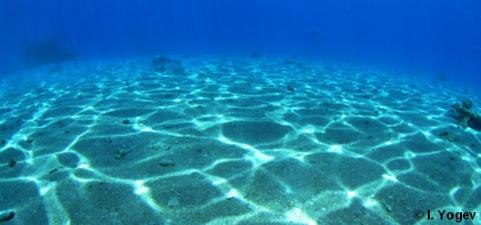
Underwater, natural illumination typically varies strongly temporally and spatially. The reason is that waves on the water surface refract light into the water in a spatiotemporally varying manner. The resulting underwater illumination field is known as underwater caustics or flicker. In past studies, flicker has often been considered to be an undesired effect, which degrades image quality. Thus, in our 2004 work, we proposed a way to attenuate the caustic pattern, creating images which appear as if taken under much more stable and uniform illumination (Deflickering).
On the other hand, in our 2009 work, we show that flicker can actually be useful . Specifically, it solves very simply, accurately, and densely the stereo correspondence problem, irrespective of the object texture. The temporal radiance variations due to flicker are unique to each object point, thus disambiguating the correspondence, with very simple calculations. This process is further enhanced by compounding the spatial variability in the flicker field and a smoothness constraint. Furthermore, in 2013 we generalized this approach for a free-moving stereo camera rig. This derives dense 3D structure, estimation of the rig motion, deflickering and descattering of underwater scenes, in addition to estimation of the water attenuation coefficients. This is demonstrated by underwater in-situ experiments.
Publications
- Yohay Swirski and Yoav Y. Schechner, "3Deflicker from motion," Proc. IEEE ICCP (2013). Best Paper Award.
- Yohay Swirski and Yoav Y. Schechner, "CauStereo: Structure from underwater flickering illumination," Invited, Proc. SPIE 8480, The Nature of Light: Light in Nature IV (2012).
- Yohay Swirski, Yoav Y. Schechner and Tal Nir, "Variational stereo in dynamic illumination," Proc. IEEE ICCV (2011).
- Yohay Swirski, Yoav Y. Schechner, Ben Herzberg and Shahriar Negahdaripour,
"CauStereo: Range from light in nature,"
Applied Optics 50, No. 28, pp. F89-F101 (2011),
Special issue about Light and Color in the Open Air.
Selected for publication at the Virtual Journal for Biomedical Optics 6, No. 11 (2011). - Yohay Swirski, Yoav Y. Schechner, Ben Herzberg, and Shahriar Negahdaripour, "Underwater Stereo Using Natural Flickering Illumination," MTS/IEEE OCEANS (2010).
- Yohay Swirski, Yoav Y. Schechner, Ben Herzberg, and Shahriar Negahdaripour, "Stereo From flickering caustics," Proc. IEEE ICCV (2009).
- Yoav Y. Schechner and Nir Karpel, "Attenuating natural flicker patterns," MTS/IEEE OCEANS, pp. 1262-1268 (2004).
Presentations
- 3Deflicker from Motion. A Narrated Presentation in YouTube.
- Stereo from Flicker (78 Mb, PowerPoint).
- Attenuating Natural Flicker Patterns (7.1 Mb, PowerPoint). The presentation references to this AVI movie (0.1 Mb). Download and place the movie in the same directory as the .ppt for the link in the presentation to work.
Data
The following links contains raw material and results of our underwater experiments:- Pool experiment (12.7 Mb, Zip).
- Red Sea experiment (22.5 Mb, Zip).
- Mediterranean experiment (45.8 Mb, Zip).
Related Research
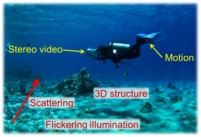 "3Deflicker from Motion" in YouTube.
"3Deflicker from Motion" in YouTube.
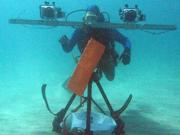
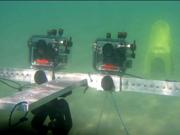 An experimental setup. The
Mediterranean.
An experimental setup. The
Mediterranean.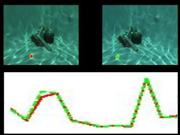 Temporal intensity curves of two corresponding
object points.
Temporal intensity curves of two corresponding
object points. 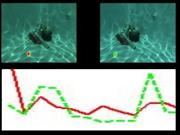 Temporal intensity curves of object points 5
pixels appart.
Temporal intensity curves of object points 5
pixels appart.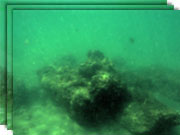 Raw images with flicker.
Raw images with flicker.
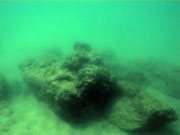 Flicker removed.
Flicker removed.


